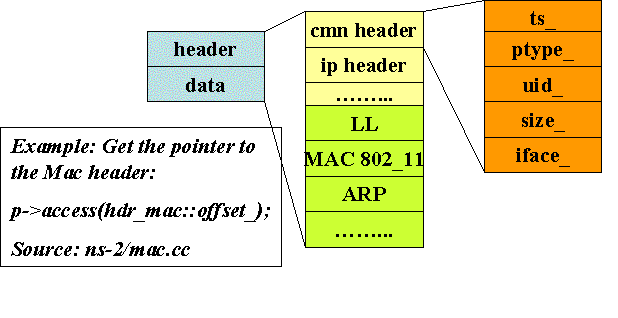A usual problem is TK8.4.5 compile failure. This is because of lack of X11 development libraries. Do apt-get install libx11-dev,libxt-dev
For
gcc 4.0.3, ns-2.28 source codes are violating programming regulations. So, some files have to be manually modified to let "make" succeed.
Generally, the declaration of "class A" has to be put before a reference appears in another class definition. For example,
class B
{
A* aa;
....
}
Also, declaration as
static const double ALPHA_ = 0.4;
in a header file, is illegal, because initialization of a static variable in header file would lead to multiple initializations occurred in all files including this header file.
So, it must be changed as :
static const double ALPHA_ // in header file
const double XCPQueue::ALPHA_ = 0.4; // in cpp file
A list of paths are given as below: (copying from ns-mail list)
diff -ru ns-allinone-2.28.orig/nam-1.11/agent.h ns-allinone-2.28/nam-1.11/agent.h
--- ns-allinone-2.28.orig/nam-1.11/agent.h 2001-06-15 21:53:10.000000000 -0400
+++ ns-allinone-2.28/nam-1.11/agent.h 2005-06-13 18:10:05.000000000 -0400
@@ -70,7 +70,7 @@
inline double width() {return width_;}
inline double height() {return height_;}
virtual void findClosestCornertoPoint(double x, double y,
- double &corner_x, double &corner_y) const = NULL;
+ double &corner_x, double &corner_y) const = 0;
virtual void place(double x, double y);
void label(const char* name, int anchor);
void color(const char* name);
diff -ru ns-allinone-2.28.orig/ns-2.28/diffusion3/lib/nr/nr.hh ns-allinone-2.28/ns-2.28/diffusion3/lib/nr/nr.hh
--- ns-allinone-2.28.orig/ns-2.28/diffusion3/lib/nr/nr.hh 2005-01-19 13:23:21.000000000 -0500
+++ ns-allinone-2.28/ns-2.28/diffusion3/lib/nr/nr.hh 2005-06-13 18:11:03.000000000 -0400
@@ -43,7 +43,8 @@
typedef signed int int32_t;
#endif
typedef signed short int16_t;
-#if defined (sparc)
+// #if defined (sparc)
+#if defined (__SVR4) && defined (__sun)
typedef char int8_t;
#else
// Conflicts with system declaration of int8_t in Solaris
diff -ru ns-allinone-2.28.orig/ns-2.28/xcp/xcpq.cc ns-allinone-2.28/ns-2.28/xcp/xcpq.cc
--- ns-allinone-2.28.orig/ns-2.28/xcp/xcpq.cc 2005-02-03 13:29:20.000000000 -0500
+++ ns-allinone-2.28/ns-2.28/xcp/xcpq.cc 2005-06-13 18:10:30.000000000 -0400
@@ -33,6 +33,15 @@
} class_droptail_xcpq;
+const double XCPQueue::ALPHA_ = 0.4;
+const double XCPQueue::BETA_ = 0.226;
+const double XCPQueue::GAMMA_ = 0.1;
+const double XCPQueue::XCP_MAX_INTERVAL= 1.0;
+const double XCPQueue::XCP_MIN_INTERVAL= .001;
+
+const double XCPQueue::BWIDTH = 0.01;
+
+
XCPQueue::XCPQueue(): queue_timer_(NULL),
estimation_control_timer_(NULL),
rtt_timer_(NULL), effective_rtt_(0.0),
diff -ru ns-allinone-2.28.orig/ns-2.28/xcp/xcpq.h ns-allinone-2.28/ns-2.28/xcp/xcpq.h
--- ns-allinone-2.28.orig/ns-2.28/xcp/xcpq.h 2005-02-03 13:29:20.000000000 -0500
+++ ns-allinone-2.28/ns-2.28/xcp/xcpq.h 2005-06-13 18:10:36.000000000 -0400
@@ -113,11 +113,11 @@
XCPTimer* rtt_timer_;
double link_capacity_bps_;
- static const double ALPHA_ = 0.4;
- static const double BETA_ = 0.226;
- static const double GAMMA_ = 0.1;
- static const double XCP_MAX_INTERVAL= 1.0;
- static const double XCP_MIN_INTERVAL= .001;
+ static const double ALPHA_ ;
+ static const double BETA_ ;
+ static const double GAMMA_ ;
+ static const double XCP_MAX_INTERVAL;
+ static const double XCP_MIN_INTERVAL;
double Te_; // control interval
double Tq_;
@@ -141,7 +141,7 @@
double b_[BSIZE];
double t_[BSIZE];
int maxb_;alter
- static const double BWIDTH = 0.01;
+ static const double BWIDTH;
int min_queue_ci_;
int max_queue_ci_;
Solution for another problem when install ns-2.28 in Debian
./configure: line 7068: ` OSF*)' tcl8.3.2 configuration failed! Exiting .
The problem is that there are superfluous "'" characters in unix/configure:
grep in unix/configure for /etc/.relid and change it
from
system=MP-RAS-`awk '{print }' /etc/.relid'`
to
system=MP-RAS-`awk '{print }' /etc/.relid`
There are more occurrences of that line in tcl, tk and
octcl with the same problem.
For
gcc 4.1.1 or above, there is a lot of coding violations. The best way is to still use gcc-4.0 to compile, change Makefile:
CC = gcc-4.0
CPP = g++-4.0


